Giger and the fantastic technologies of the Alien world

This article comes out at the point of space and time between two dates that are important for the genre of "dark" fiction. On May 12, 2014, the “father” of biomechanoids, the forerunner and mastermind of cyberpunk, artist Hans Rudolf Giger, passed away. On May 18, 2017, the next part of Alien, the sixth film of the series, will be released in Russia (except for the criticism of Alien vs. Predator, destroyed by critics).
By 1979, Giger had fully formed the image of the “hero” of terrible dreams about space - xenomorph, who had a great influence on the whole subgenre of planetary fiction. Many of the creators of the first "Alien" are no longer alive, but the cosmic stranger himself is still alive. For almost forty years, a huge amount of material has accumulated on the Alien universe - unrealized scenarios, art, sketches, memories of the creators. The story of how films were created can be no less interesting than any part of Alien.
Prequels, prequels and spin-offs revolve around a host of alternative plot lines. The fantasy of the authors regarding the futuristic technologies from the first film overtook the possibilities of the budget. Unfortunately, very little of what was conceived could be embodied on the screen. Today you will get some insight into the technologies that exist in this universe, as well as what remains behind the scenes (perhaps not forever).
Biomechanoid
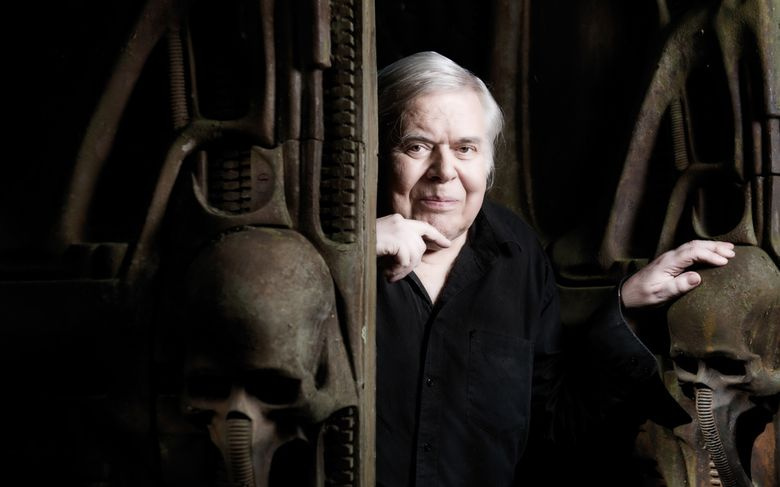
Giger was born in 1940 in Switzerland, where he lived all his life. The first works made in ink and became sketches and sketches of future themes, the Swiss published in 19 years. Even then they traced the theme of dark expressive images, as if coming from deep nightmares.

In 1968, Giger, after the release of the series of paintings "Biomekhanoidy", comes the first full recognition in his homeland. In it, unlike anything creatures that combine mechanical elements and the miracle of the triumph of genetics, lie both the foundations of the Alien’s future appearance and the visual embodiment of the darkest ideas about cyberpunk connecting living and nonliving matter.
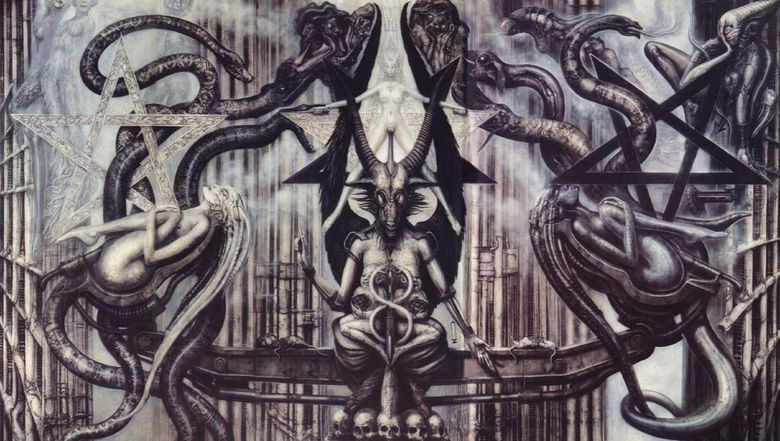
In 1976, a collection of ten years of work by the artist - posters of the series "Necronomicon". Of course, Giger read Lovecraft, knew all the myths of Cthulhu, had great respect for the writer, but in the Necronomicon of Giger, Lovecraft was vanishingly little.
Lovecraft horrors are stingy in the narrative of various nightmares, the writer relied on the reader's imagination. "I can not quite fully describe everything that happened before my eyes," - quotation to fully describe Howard Lovecraft's prose. "Myths of Cthulhu" give any artist the opportunity to roam around in creating creatures of intergalactic horror, without violating the author's ghostly canons.
However, Giger, paying tribute to the ancestor of the cosmic horror genre, did not seek to embody other people's nightmares in painting - he had enough of his own. Giger has no drawings of the Ancient Gods - like a real creator, he painted what he saw inside himself - but with Lovecraft, he had a love for the cosmos in which no one could hear your cry.
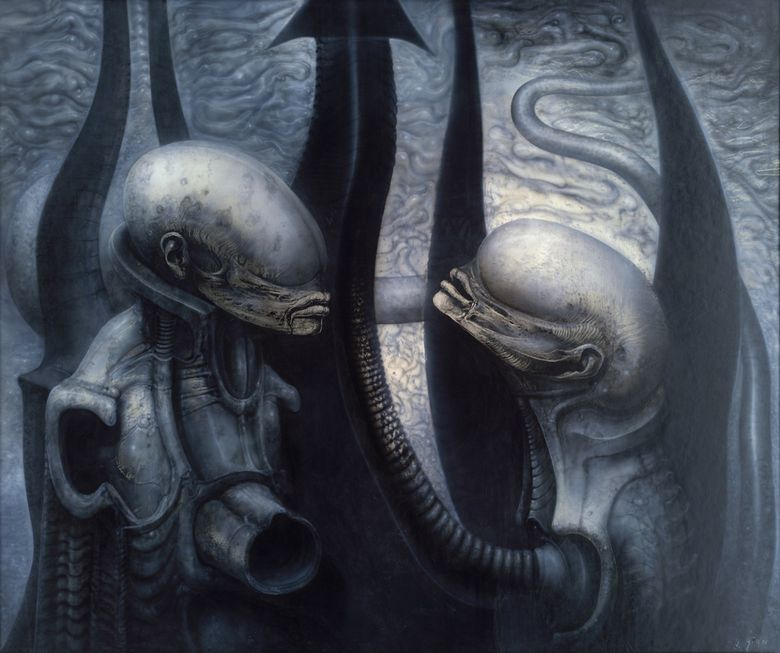
The photographic effect of the artist sought with the help of a spray gun, spray paint. Thus, Giger did most of his late works.
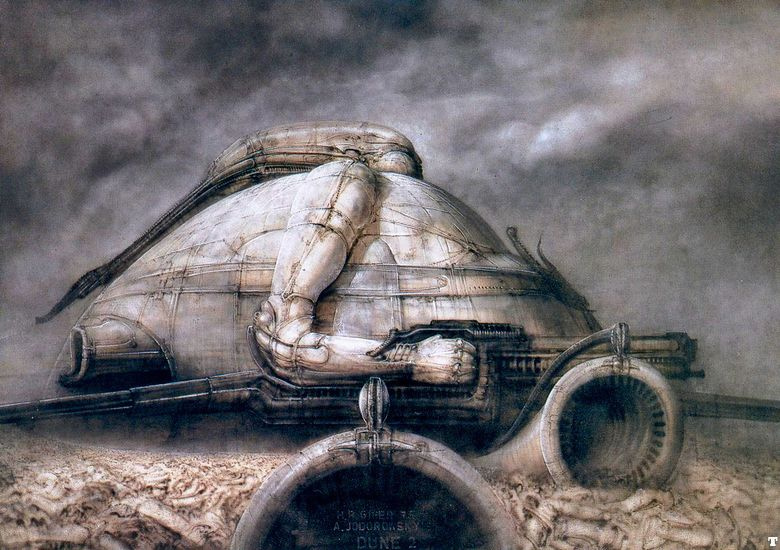
Space theme fully captured Giger in 1977, when his work caught the eye of director Alejandro Jodorowski, who conceived of the film version of Frank Herbert's famous science fiction novel Dune. Khodorovsky invited Giger to work on the whole visual tape, including room design, clothing, architecture. The film, which passed through the entire production hell of Hollywood, did not take place, but the illustrations to “Dune” remained.
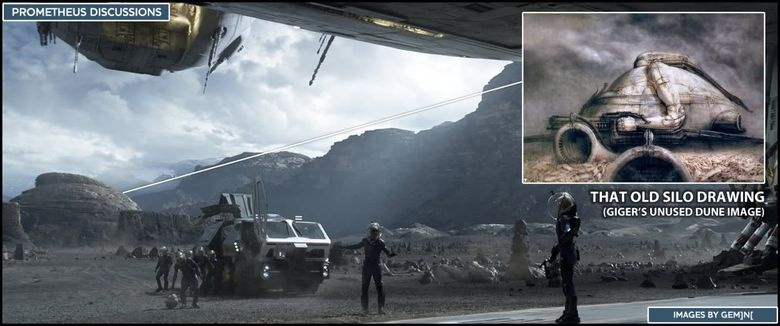
Moreover, Giger’s drawings for Dune still inspire directors. Take a look at the frame from “Prometheus”, repeating the gigier sketches.

These references are not just a homage to the master. In 2011, Giger presented numerous sketches for the film "Prometheus". Officially it is believed that Giger's work has never been used during the shooting. However, if you look at the drawings, there will be a clear resemblance to the bestiary presented in the film - and this despite the large team of Ridley Scott's own designers.
Jodorowski drew Dan O'Bannon, the creator of the effects in John Carpenter’s debut student film, The Dark Star, to work on the special effects of Dune. O'Bannon became known, having received an award from the Academy of Science Fiction films of the USA for the best special effects to Dark Star, but he was more drawn to writing.
In 1976, he wrote the story “Long Tomorrow”, illustrated by French artist Jean Giraud, who also worked on Dune. Later Giro will take part in the creation of the films "Tron", "The Abyss", "The Fifth Element". These illustrations will inspire Ridley Scott while working on the movie "Blade Runner" (a continuation of the free film adaptation of Philip Dick, too, will be released in 2017).
After the failure of "Dune" O'Bannon was left without money and was forced to live with his friend, the beginning screenwriter Ronald Shusett. Shusett will give some valuable advice for the future of the “Alien” - he has the idea of replacing ordinary alien blood with acid.
O'Bannon was in a hopeless situation and saw for himself the only way to salvation - to write an excellent script and sell it profitably. In just a few months he managed to work out the idea of a film about astronauts who sat down on an uncharted planet and faced a hostile form of life.
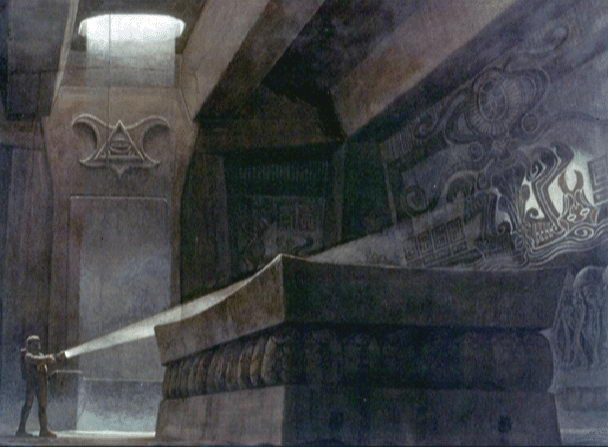
In the first version of the script, the spacecraft was an alien pyramid. Inside, everything looked appropriate - as in the tomb of the Egyptian Pharaoh
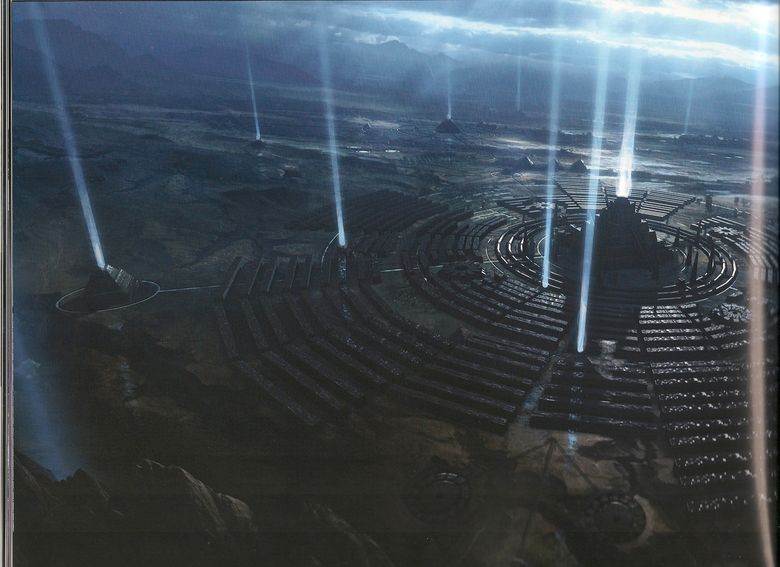
Later, the pyramids were planned to return to Prometheus, but this idea was abandoned.
The original script, like all subsequent versions created by producers, was not replete with detailed accuracy. The text did not say anything about the past of the characters, and even their gender was not defined - each role could be given to both men and women.

As for the Alien himself, the alien monster in the O'Bannon's illustration looked awkward by today's standards.

This is the final! Any scene with such a stranger transforms
In the second half of '76, something rarely happened to novice writers - O'Bannon finished the script and quickly sold the rights to the film version. And on May 25, 1977, a movie entitled “Star Wars” was released, which gained tremendous box office success and saved the 20th Century Fox Film Corporation film studio from bankruptcy.
After the successful hire of the adventures of the Jedi in the “20th Century Fox”, they were surprised to see that the rights to Star Wars remained with George Lucas. It was urgently necessary to find a new movie about space for which the studio would have much more rights. By the way, the “Alien” turned up, the work on which was carried out in the sluggish mode of scenario edits.
The wheels of filmmaking spun quickly, and the film was run by aspiring director Ridley Scott, who by that time had shot several hundred commercials and successfully debuted with Duelists tape.
Despite the small experience in the movie, Scott zealously got down to business and began to change the script and concept of the film for himself. First of all, he did not like the design solutions proposed by O'Bannon and the producers of the picture. The writer, deciding that a true artist should be engaged in design, suggested considering Giger's candidacy as a production designer. O'Bannon simply showed Scott the Necronomicon of Scott.
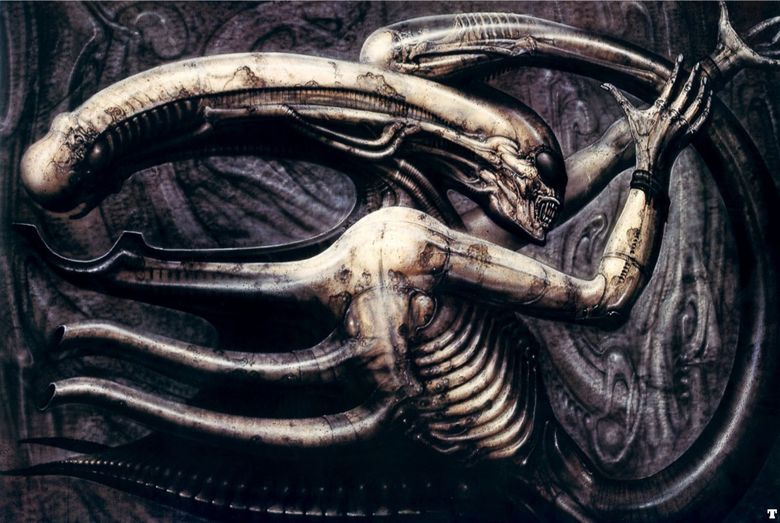
Picture Necronom IV from "Necronomicon"
Giger made such an impression on Scott that the director gave the artist complete freedom of expression. Giger, besides the Alien himself, drew and even partially built, using the skills of the sculptor, the look of the entire life cycle of the newcomer (egg, hypocrite, embryo, bastard, adult), the space jockey (the alien body in an alien ship that was wrecked on the planet), interior horseshoe-shaped spacecraft, the landscape of the planet LV-426.
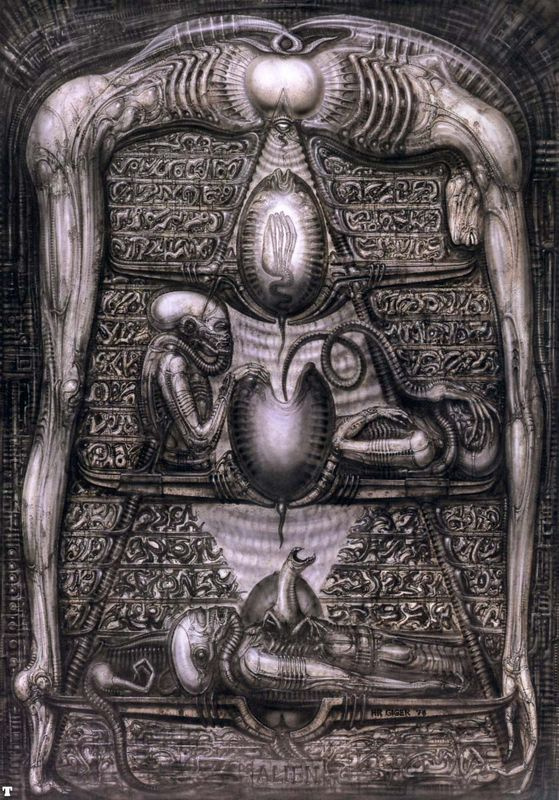
Life Cycle Development Alien
The planetoid LV-426 rotates next to a double star in the constellation Grid. This star system really exists, but whether there are planets there is not yet known. In the film "Prometheus" appears fictional planetoid LV-223, located in the same system Zeta Grid.

Initially, Giger had to remotely engage in the "visual" - all work was to prepare the illustrations and send them to the studio. However, the team working on the film could not cope with a violent fantasy and adequately display the vision of the project by the master. Then Giger personally flew to England and led the project, in many respects independently working on the construction of the shooting props.
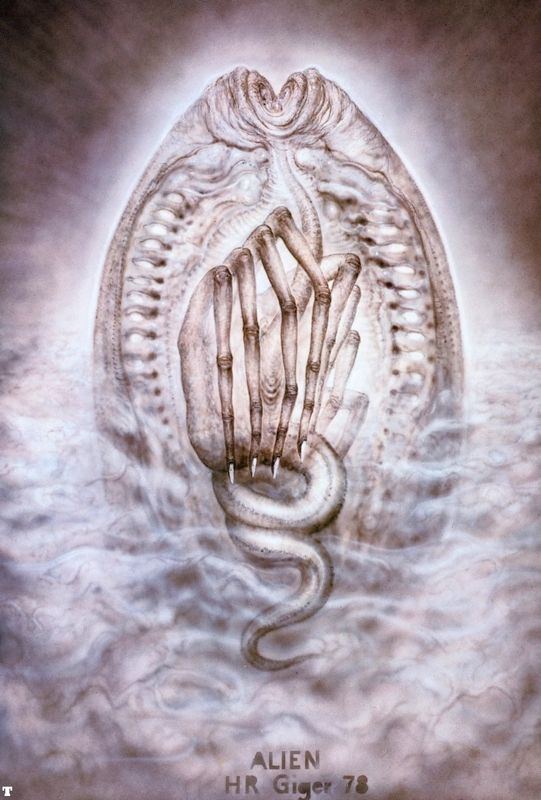
Creative freedom came out sideways — the producers were horrified and forbidden to use the cyber-erotic aspects introduced by Giger in the film. Ridley Scott was on the side of the energetic Swiss, but the 20th Century Fox had the last word. For example, the Alien's egg has changed - in the illustration above you see the original version, which did not fall into the film.
In addition to censorship, Giger faced purely financial constraints. According to the original idea, the skin of the Alien was supposed to be transparent - the viewer would see the circulatory system and internal organs of the newcomer. The lack of budget did not allow to realize the idea (this idea will be partially returned in the film “Alien: Resurrection”).
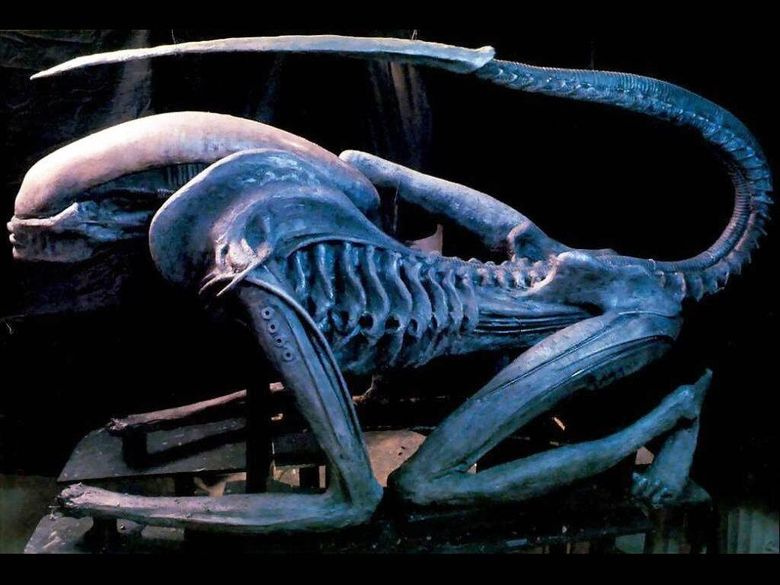
Sculpture built for the movie "Alien 3"
Except for the two points above, Giger did everything he wanted for the film. And "Alien" was the only picture in which the artist was able to fully embody his visual finds, for which he absolutely rightly received an Oscar in 1980. All other ideas for Hollywood were only partially implemented in other films, or disappeared into production hell. Giger was attracted to work on the films "Poltergeist 2", "Alien 3" (the kind of new Alien did not get into the picture), "Individual", "Batman Forever", "Prometheus".
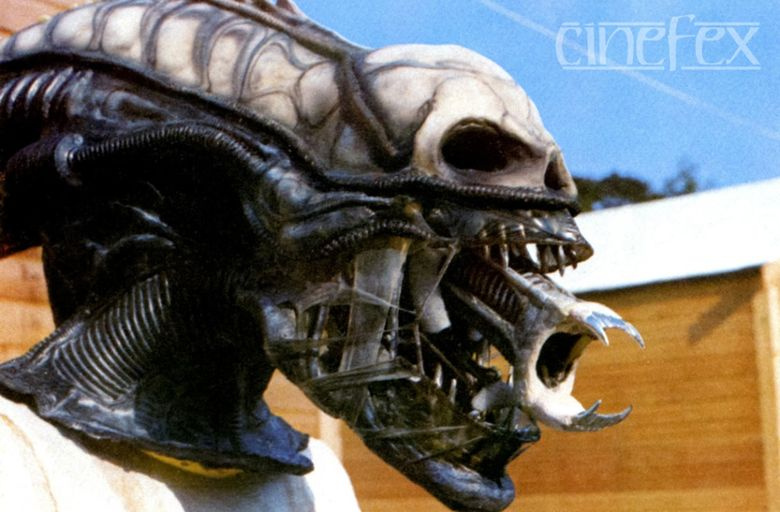
What does the Alien consist of? According to mythology, the Alien consists of both organic and inorganic compounds and is a synthesis of silicon-metal and carbon structures. The outer exoskeleton consists of polarized organic silicates and metal. According to writer Alan Foster, the Alien is covered with protein polysaccharides and replaces them with polarized silicone when cells are lost, which increases its resistance to environmental conditions - these ideas do not contradict the ideas of Giger and Scott, and can be perceived as a canon.
This is only a brief summary of the story of "Alien." The full version of making all the films pulls into a series of books. But on this we finish the narrative and turn to the visual, namely, consider the various fantastic elements of films. Below are interesting models, but not all - unfortunately, many sketches and art from films are not freely available.
From "Nostromo" to "Prometheus"

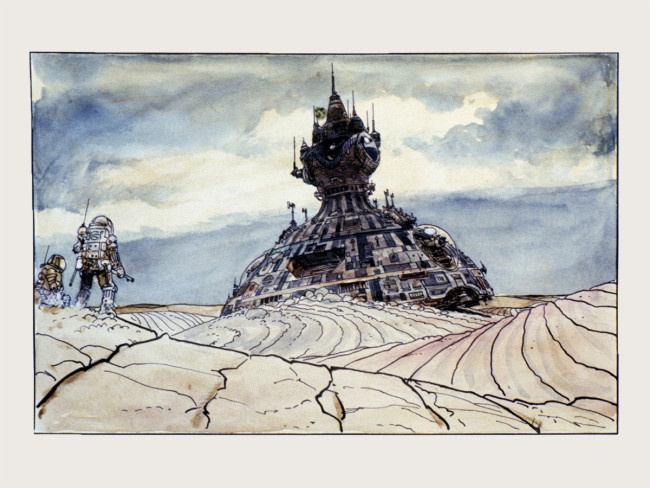
The well-known “bagel” is the fruit of Giger's sleepless nights. The original appearance of the alien spacecraft has changed several times. In the first case, it was a pyramid, and in the sketch above you see the second version
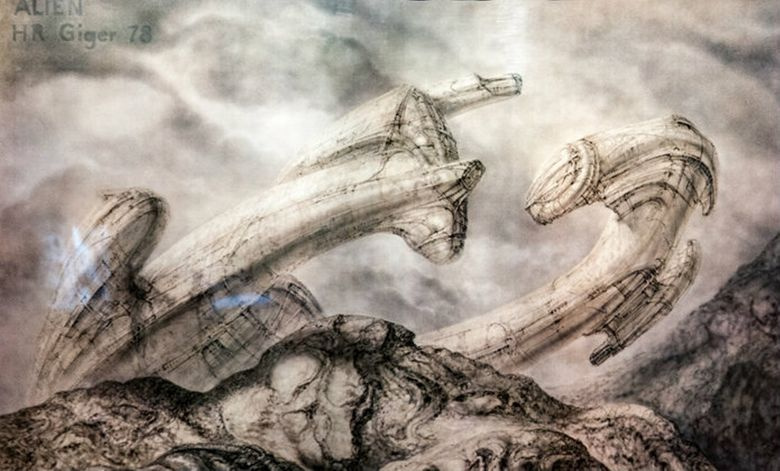
The toroidal version of Giger became a real event not only for the “Alien”, but also for all space fiction.

One of the sketch drawings of the space tug Nostromo. The concept was also changed several times, but there were no radical changes in the style of Giger.

Compared to today, the interfaces and exteriors on the Nostromo spacecraft from the film of the 79th year were closer to the reality of that time. It is now in each film we are shown holographic screens and multi-kilometer space engines, and then people had enough of a simple monitor in a small room.

Only buttons, only hardcore.
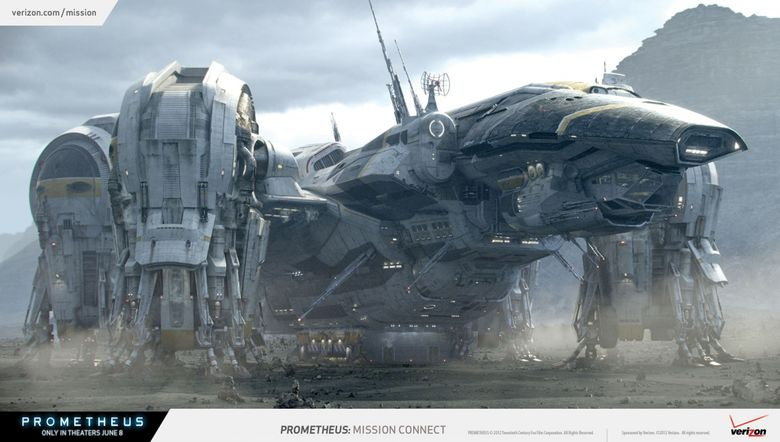
In the film "Prometheus" the action takes place before the events of the first "Alien", but the difference in technology compared with the film 40 years ago is noticeable immediately.
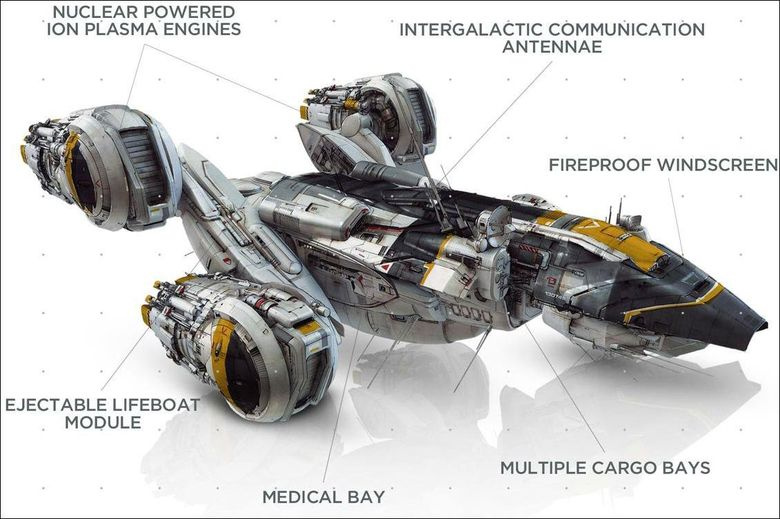
According to mythology, one of the largest spacecraft of the Weyland Corporation since 2034 - USCSS Prometheus, was commissioned in 2072. Inside there is a 2.1 terawatt fusion reactor. The ship is equipped with hybrid engines capable of operating in interstellar and atmospheric modes. Weyland Industries did not equip this ship with weapons - as, incidentally, any other aircraft of the Aliens universe.
UD-4L

And this is from the "Aliens." Multifunctional combat transport ship designed to transport troops and materials from the orbital ship to the planet. He is also well armed and armored and acts as air support for the ground forces. The design was strongly influenced by James Cameron’s passion for the theme of the Vietnam War. The original concepts made by the artists differed in the direction of greater futurism, but the director reworked everything to give the ship credibility.
Sulako

Sulako is a fully automated military ship, controlled by an advanced computer with artificial intelligence, which is able to independently pilot the ship and defend itself. A ship needs only one crew member to operate.
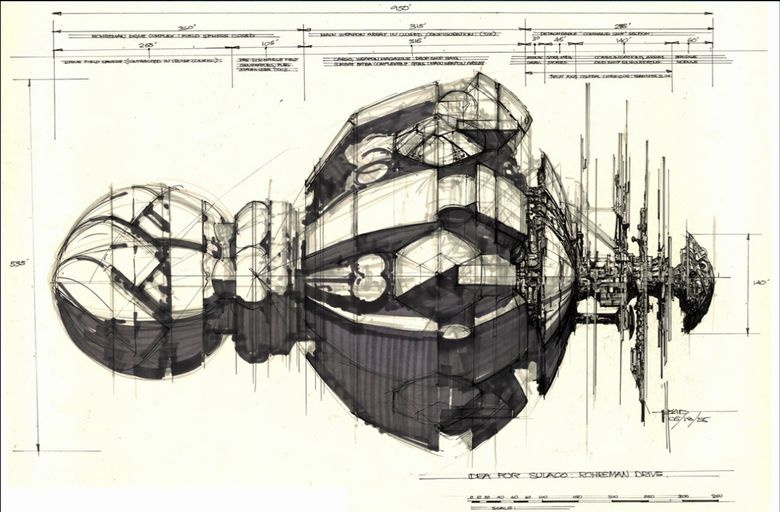
Like all other aspects of the picture, the design of the spacecraft in "Aliens" Cameron painted himself. Initially, of course, professional designers took up the case (the example in the illustration above), but the director was not satisfied with their work.
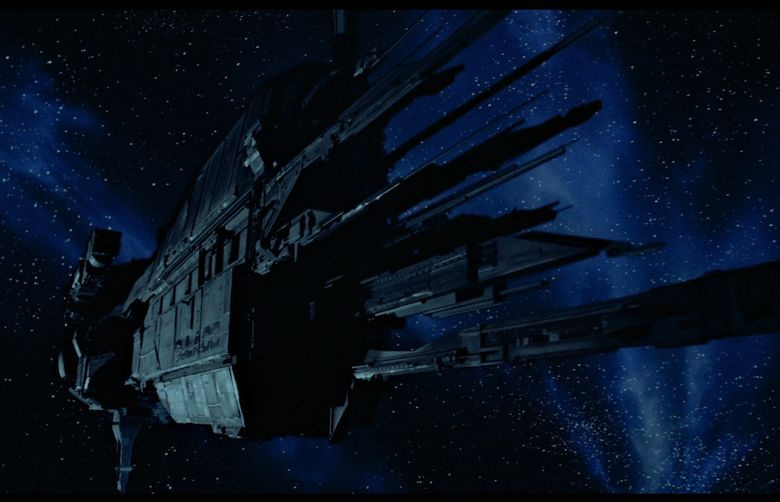
A warship, bristling with sharp wedges, really looks impressive even by today's standards.
The “aliens” are generally surprised by the elaboration, realism and attentiveness to details, which is clearly visible in some models of equipment.
Armored personnel carrier

There is no such thing in Aliens that Cameron would not put his hand to. Just look at the first concepts of technology (here you have a marines armored personnel carrier) in order to understand what changes the director made.
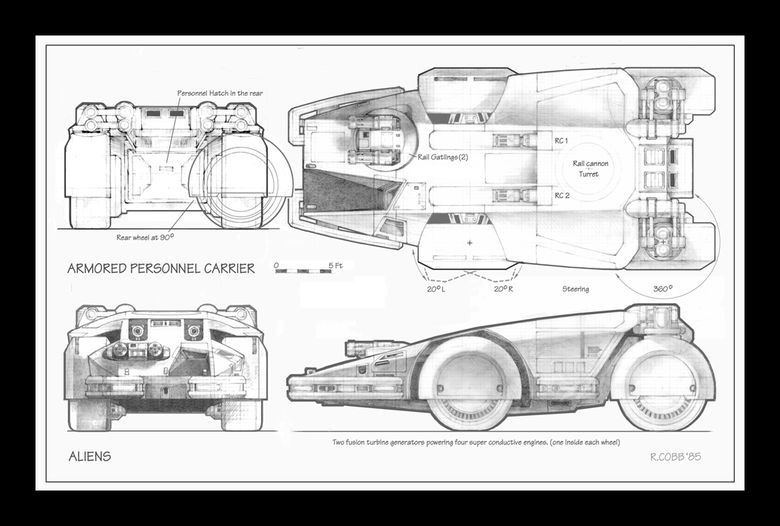
Some things had to change because of the eternal budget constraints. It turned out to be difficult and expensive to build an armored vehicle, so a real tractor from the airport was taken as a basis, and then the car was rebuilt into a more futuristic design.

This is how the transport of the future actually looks like.

Sectional view. If you want to independently examine every detail, at the end of the article there are links to the source.
Androids
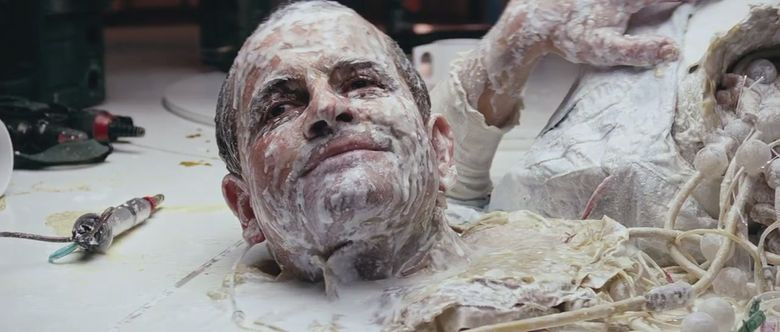
Androids play a large role in the Alien universe, although in the original script of the first movie of a humanoid robot was not at all, it appeared while working on the project of the production group. Androids have organs that mimic the insides of people, and the role of blood (or, perhaps, machine lubrication) is played by a white liquid, like milk.
In Alien, the Ash model of Hyperdyne Systems 120-A / 2 spits on all the laws of robotics and introduces important social and cyberpunk overtones to the narrative — Weyland-Yutani acts on its behalf, which always puts its interests above any the number of human lives. Subsequently, androids with an unstable psyche become an important element of the series, appear in almost all films, with the exception of "Aliens." Prone to humanism Cameron in his picture adds Bishop, who respects Isaac Asimov’s legacy and helps Ripley.
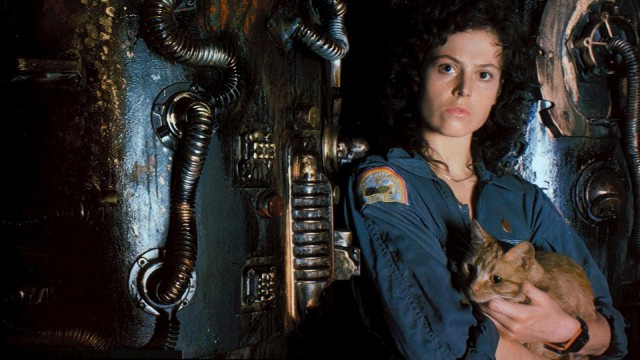
Speaking of Ripley. As we wrote on Mail.Ru Kino, Sigourney Weaver became the only woman in the rating of the most popular characters of Empire magazine - her heroine Ellen Ripley was ranked fifth in the overall standings.

Before Prometheus, cybernetic creatures looked and acted like humans, most often trying to act covertly. In Prometheus, David performs the functions of a mechanical servant, and the avarice of his emotional involvement in what is happening leaves no doubt about his synthetic origin.
Exoskeleton
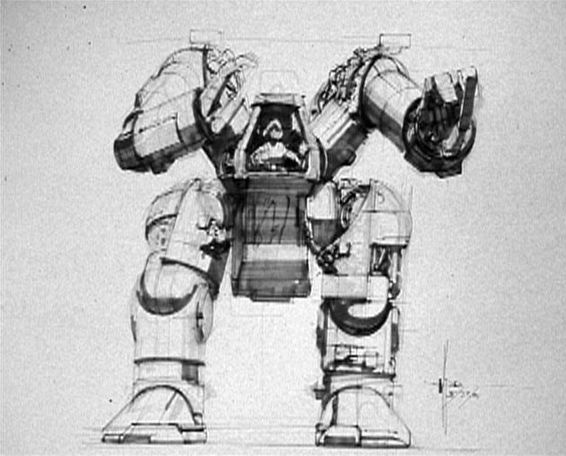
Initial view of the loader, which could not be built
Although nobody calls the electric truck an exoskeleton in Aliens, it was used precisely as a hydraulic suit. Exoskeletons, repeating human biomechanics, appeared in the 1960s and sank deeply into the soul of James Cameron. So much so that they will stay with him until his death or at least until 2025, when the final Avatar will be released. The original version of the loader concept for “Aliens” looked exactly like the model from the “Avatar”.
Weapons

Homemade flamethrower took place in the pantheon of glory "Alien"
In the first "Alien" weapons as such was not - the action took place on a spacecraft, and any injury to the newcomer would turn the body into a sieve. In the third part, firearms are also not used. In the film "Alien: Resurrection" flashes a lot of homemade unique samples made from all kinds of garbage. And a little more in “Prometheus”, but also no future technologies.

Concepts of the method of movement of the French wheelchair user and his weapon in the film "Alien: Resurrection." No wonder many see the film as a satire for the future.
James Cameron, filming the fantastic action movie “Aliens”, could not do without weapons. As in all of his other films, instead of futuristic designs, Cameron showed the viewer as close to reality as possible.

The M41A Pulse Rifle is an air-cooled assault rifle made from aluminum, titanium and carbon fiber alloys. Magazine is loaded with cartridgeless cartridges. Battery capacity is designed for 99 shots at a rate of 900 shots per minute (shooting mode can be changed).
The weapon is equipped with an electronic ammunition counter and a grenade launcher with high-explosive fragmentation grenades. But this is all in the film. In reality, Cameron used a hybrid of two Thompson M1A1 shotguns, the Remington 870 and Franchi SPAS-12. As a result, “M41A Pulse Rifle” he likes so much that he uses a rifle in the movie “Terminator 2: Judgment Day” (it just so happened that this picture in the 3D version will also be released this year).
Rifle liked not only the director. Fans created their own copy of the shoot .
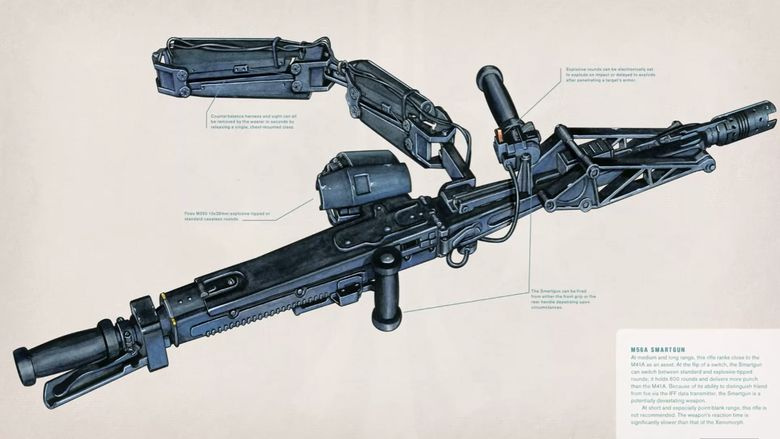
Pulsed intelligent machine gun, which was based on the real German machine gun MG-42. The total length of the weapon exceeded 125 centimeters.
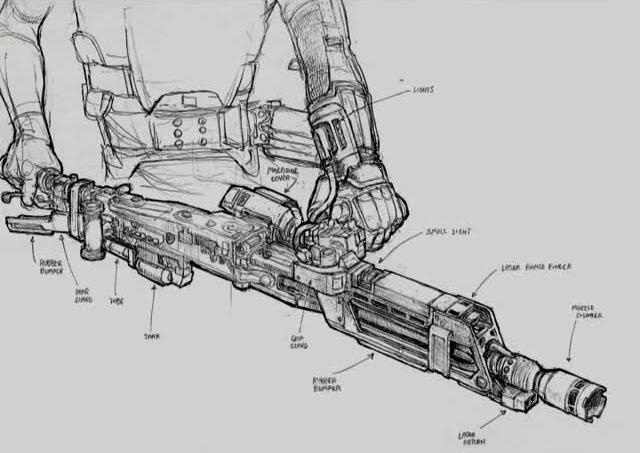
If you do not know what Cameron is doing in the long breaks between his films, then here's an idea for you - he draws in details the concepts of all the technology.
Terramorfing

The subject of terramorphing rises even in "Aliens." A cunning alien predator captures a colony of terraformists on LV-426. In the film Prometheus, they planned to return to this topic - in the initial version of the script, Peter Weyland, the founder of the Weyland corporation, showed no interest in the proposal to finance an expedition to Zeta of the Grid constellation. He changed his mind when he was convinced that Engineers (the type presented in the first film by the Space Jockey) had working terraformation technologies (Wayland's project on Mars terraformation presented by the concept above was too complicated).
Motion Detector
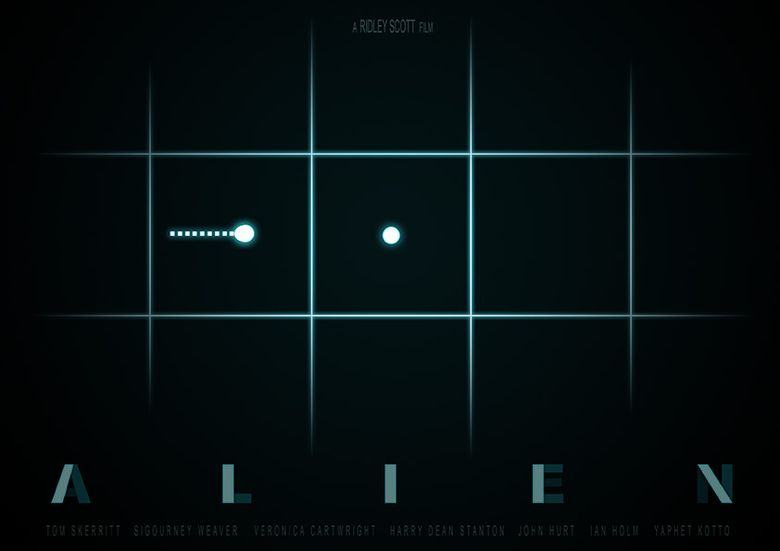
The motion detector, which terrifies both the characters and the spectator, selects moving objects from the stationary background of the environment within a radius of up to 1000 m (with the actions of several groups in a limited space, the range decreases to 50-25 meters). The detector works by transmitting the reflection of the electronic signal. We created several prototypes for filming using various materials at hand — an electric drill, a camera, a calculator, and an installation screen for viewing slides.
Wooden planetoid and other follies
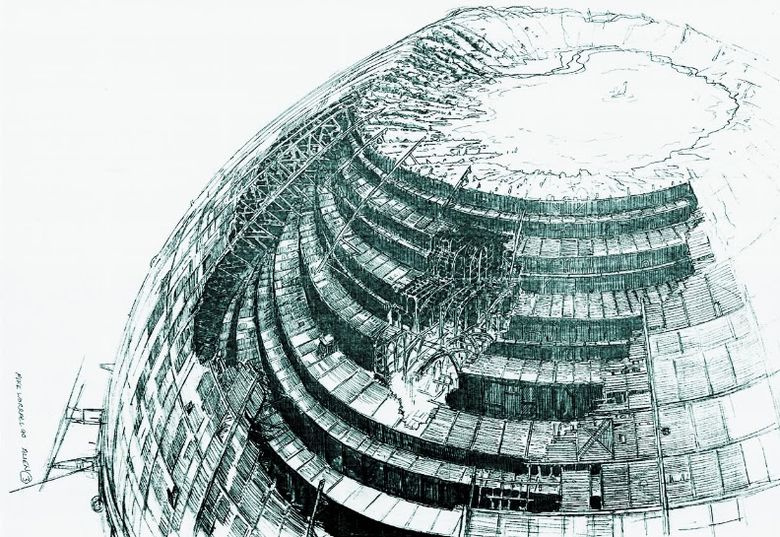
Gather together all the rejected ideas on the "universes" of "Star Wars", "The Matrix" and "Terminator" and still they will be few and inconspicuous compared to the unrealized scenarios of the movie "Alien 3" alone. Suffice it to say that initially 11 scenarios were written for the film - these are only those we know about.
Because of the confusion created on the project, a huge number of ideas from more than nine authors have disappeared into oblivion. Moreover, even about Giger, who sent his concepts for the film and even built a full-fledged model of the Alien for his own money, was completely forgotten and did not include his name in the final credits. The artist had to sue in order to defend his right to be called the “Alien’s“ father ”.
As a result, all the people involved in the project were unhappy with the picture. The studio and the producers were not satisfied with the box office, the director David Fincher generally believes that the film was ruined by greedy studio bosses and disowned from authorship; The scriptwriters remained unsatisfied, whose ideas were either thrown into the dustbin or perverted, and Sigourney Weaver swore off to participate in the continuation of the saga (but later her heart melted).
Few people know that the grand master of cyberpunk William Gibson himself wrote the first script for the third part of “Alien”. The producers did not like his work. They thought that in it, ironically, as if it did not sound, there were few fantastic elements. Although the main idea - the confrontation of two transnational corporations fighting for the possession of absolute biological weapons - responded to the spirit of the times and was a clear allusion to the cold war, continuing the theme of social fiction, touched upon in the first part. But the collapse of the communist bloc of countries that happened after a short time finally buried this idea.
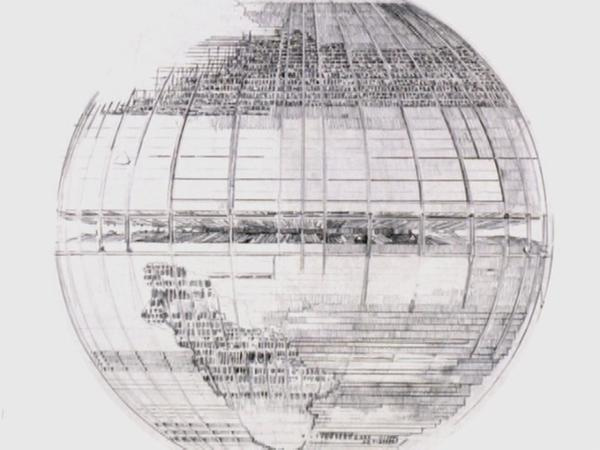
How the little-known director and screenwriter Vincent Ward got into the project is silent, but he has an amazing idea even by today's standards of a wooden planetoid on which the order of hermit monks, opponents of all sorts of technologies, lives. Such a kind of dieselpunk in space is a magnificent surroundings for an alien predator, which is traditionally driven by a flamethrower.

How could this thing not fall apart in space? The script provides several evasive explanations, the essence of which can be reduced to one phrase: “yes, because, why not.” On the other hand, even in Dan Simmons, in the Hyperion tetralogy, new life forms just fly around in space - and nothing, everyone liked it.
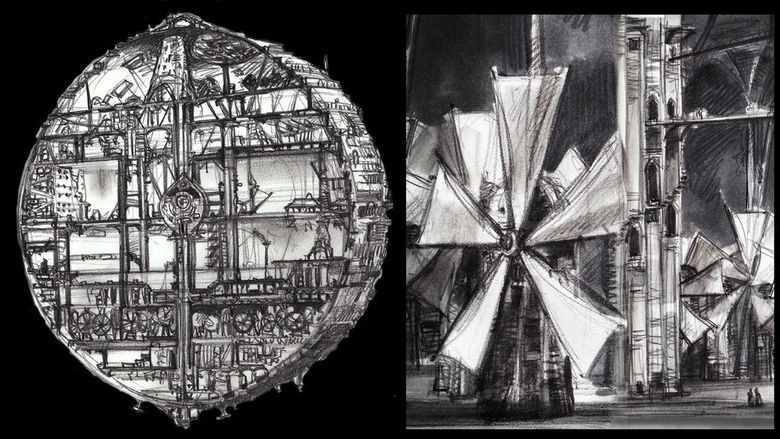
To some extent, the remains of this scenario were included in the film - instead of the order of monks with windmills, we have another closed male community, represented by prisoners of the space prison. There are also practically no weapons in the finished film, just as pacifist monks did not have it.
Another screenwriter, Eric Red, having shown a hefty fantasy, offered to infect the space station with an alien virus, as a result of which the orbital ship turned into a multi-kilometer Alien. It is a pity that no art has been preserved for this scenario. Should I talk about other ideas where Aliens landed on Earth and made a planetary hell or lured people to their home planet or turned out to be, in general, not such bad creatures?
Heritage
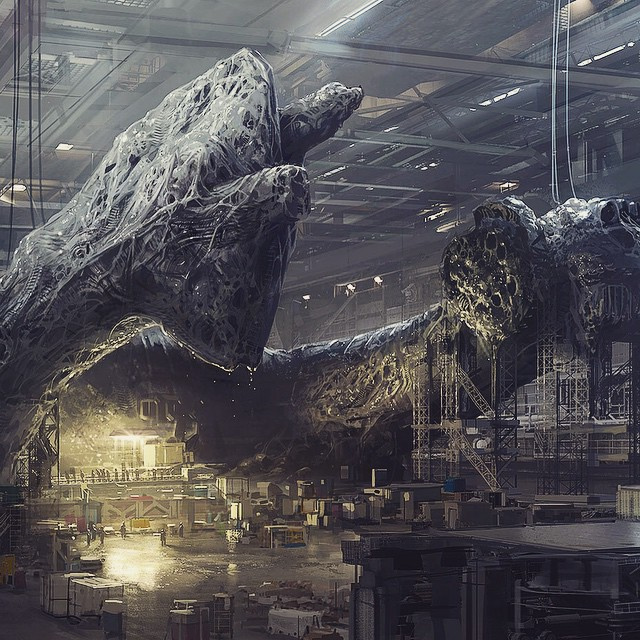
The concept of the film "Alien-5", presented by director Neill Blomkampom. Project canceled
Even if once another film on "Aliens" with a crash fails at the box office, with us will always work Giger. They are truly eternal.
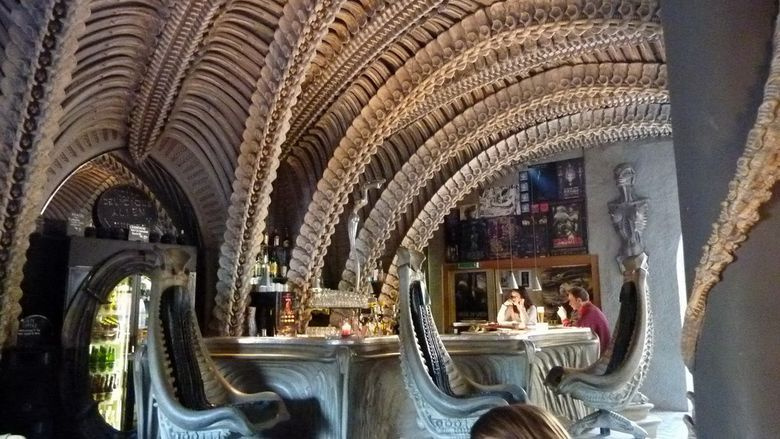
Giger Bar in Kura, Giger's hometown
«» , . , , , — , 70- , .
( «»), , . . , .
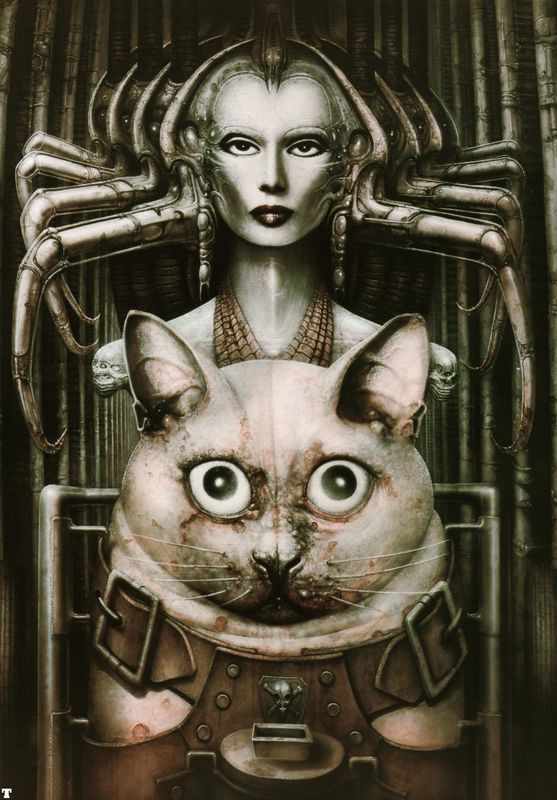
, , , . , , , .
Sources:
Alien: The Weyland-Yutani Report
Alien the Archive: The Ultimate Guide to the Classic Movies
«»
')
Source: https://habr.com/ru/post/403915/
All Articles